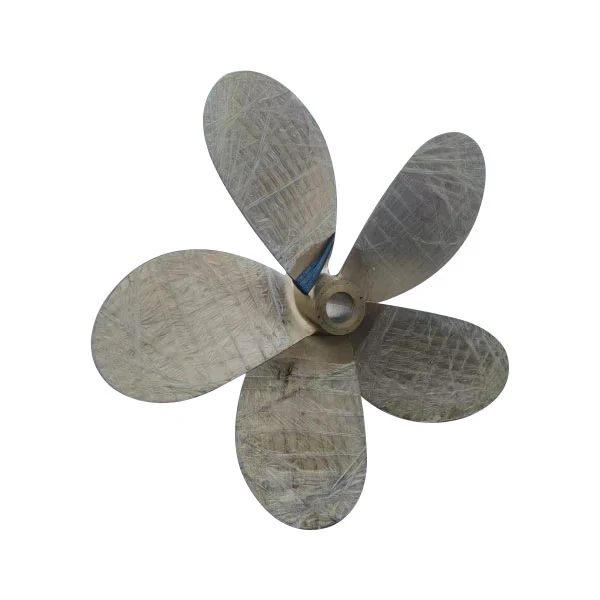The Importance of Marine Propellers: How They Drive Your Boat’s Performance
2025-06-07
When you think of a boat, you probably picture the sleek hull slicing through the water, the engine roaring, and the propeller spinning beneath the surface. But the marine propeller is more than just a piece of machinery—it’s the heart of the boat’s movement. It plays a critical role in propulsion, maneuverability, and fuel efficiency. In this blog, we’ll explore the importance of marine propellers, how they work, and why selecting the right propeller is essential for optimizing your boat’s performance.
1. What is a Marine Propeller?
A marine propeller is a rotating device that converts the engine’s rotational energy into thrust, allowing the boat to move through the water. It's usually made up of blades (or fins) that are angled and shaped to push against the water. These blades create pressure differences on either side, generating forward motion.
Function: Propellers generate thrust by spinning through the water. The shape of the blades is designed to push water backward, propelling the boat forward.
Design Variations: Propellers come in various shapes, sizes, and materials, each designed for specific types of boats, engines, and water conditions.

2. The Role of Propellers in Boat Performance
The performance of your boat is directly influenced by the type of marine propeller you use. Whether you're using your boat for leisure, sport, or commercial purposes, the right propeller can make a huge difference in how efficiently and smoothly your boat operates.
Speed and Power: The propeller determines how fast your boat can go by generating the necessary thrust. A larger propeller with more blades may provide more thrust but could also reduce speed. A smaller, more efficient propeller may increase speed but sacrifice power.
Fuel Efficiency: A properly selected propeller helps optimize fuel efficiency. If your propeller is too large or too small for your boat, the engine may have to work harder, leading to wasted fuel. Choosing the right propeller allows the engine to operate at its ideal RPM range, saving fuel.
Maneuverability: Propellers also affect how easily a boat can turn or move in tight spaces. A well-matched propeller provides better handling and quicker response times, which is essential for docking, water skiing, or navigating through crowded waters.
3. Types of Marine Propellers
There are several types of marine propellers, each designed for different boat types and applications. Selecting the right one depends on the boat’s use, size, engine type, and operating conditions.
Aluminum Propellers: These are a common choice for recreational boats due to their affordability and lightweight design. While they are less durable than stainless steel, they are a great option for casual boaters who use their boats in less demanding environments.
Stainless Steel Propellers: Stainless steel propellers are more durable and resistant to corrosion, making them ideal for high-performance boats or those that frequently operate in saltwater. They also provide better performance at higher speeds and reduce flexing.
Bronze Propellers: Bronze propellers are known for their durability and ability to resist cavitation, a common issue that can cause damage to propellers. They are often used in commercial vessels or boats that are subject to heavy use.
Composite Propellers: Made from composite materials like fiberglass or plastic, these propellers are lightweight and corrosion-resistant. They are often used on smaller, more budget-friendly boats.
4. How to Choose the Right Propeller
Choosing the right marine propeller is crucial for maximizing the performance of your boat. Several factors should be considered when making your selection:
Boat Type: The type of boat you own plays a significant role in choosing the right propeller. For example, a fishing boat might prioritize fuel efficiency, while a speedboat would focus on maximizing speed.
Engine Size and Power: The size and power of your boat’s engine must match the size and pitch of the propeller. An undersized or oversized propeller can cause your engine to operate inefficiently.
Operating Conditions: Consider the environment in which your boat will be used. Saltwater, fresh water, shallow or deep waters—all these conditions can influence the type of propeller that’s best suited for your needs.
Pitch and Diameter: The pitch of the propeller refers to the angle of the blades, while the diameter refers to the overall size. A higher pitch generally results in higher speeds but less torque, while a lower pitch offers more thrust and easier acceleration.
5. Maintenance and Care of Marine Propellers
Proper maintenance of your propeller is essential to ensure it performs well and lasts longer. Here are a few tips for keeping your marine propeller in top condition:
Regular Inspections: Check for signs of wear, corrosion, or damage after each use. Look for dents, cracks, or missing blades, which can affect performance.
Cleaning: Regularly clean the propeller to remove barnacles, algae, and other debris that can cause drag and reduce efficiency.
Balancing: If your propeller is out of balance, it can lead to vibration, which can damage both the propeller and the engine. Ensure the propeller is properly balanced to prevent unnecessary strain on your boat’s components.
Storage: When storing your boat for the winter, ensure the propeller is dry and free of water to prevent rust or corrosion.
Conclusion:
The marine propeller is a vital part of your boat’s performance, directly influencing its speed, fuel efficiency, and maneuverability. Whether you're cruising on calm waters or navigating through rough seas, the right propeller ensures that your boat runs efficiently and safely. By selecting the appropriate material, pitch, and size, and maintaining your propeller regularly, you can ensure your boat delivers the best performance possible. Always consult with experts and manufacturers to make sure you’re choosing the perfect propeller for your specific needs.


